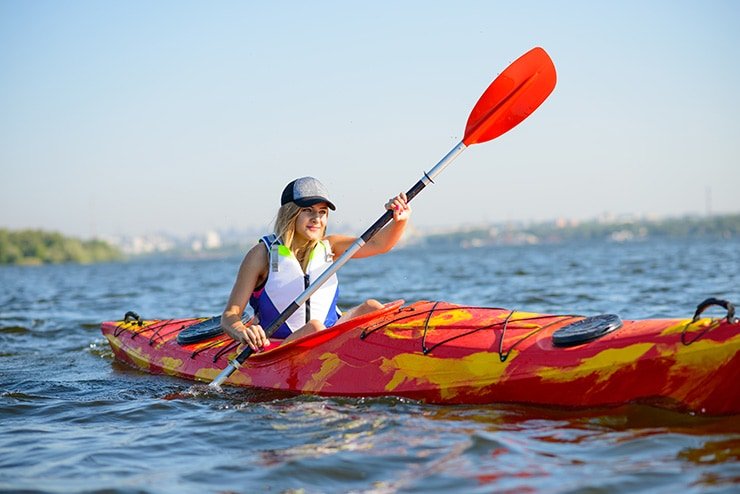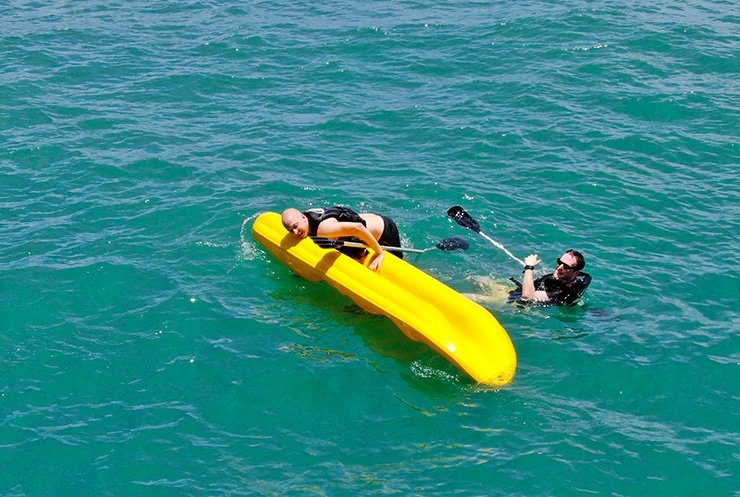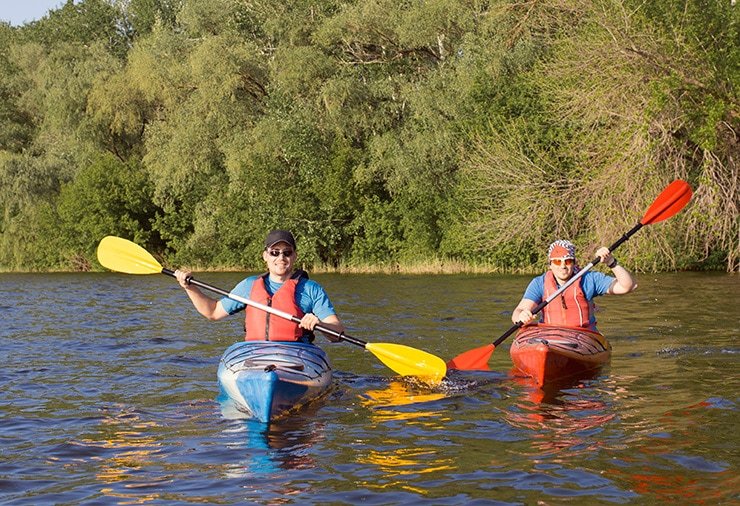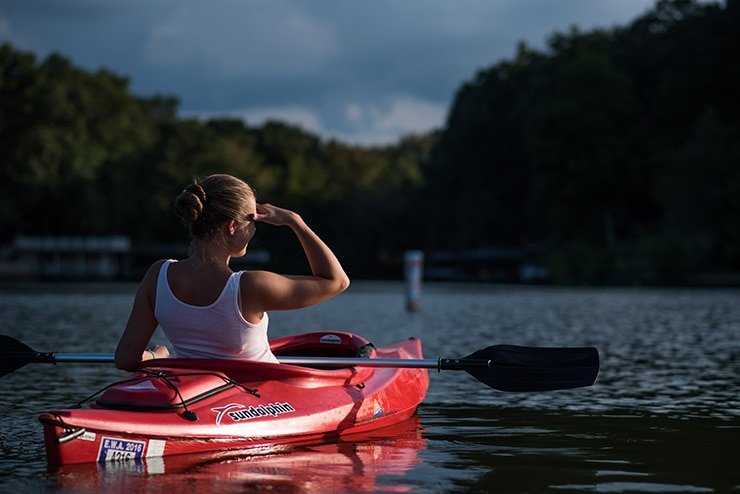In any sport or activity, there is a risk of injury, but being forewarned can prevent some of the more common kayaking injuries. While being injured is never a happy experience, it can happen to anyone.
There are all sorts of possible injuries sustained from kayaking, ranging from chronic overuse injuries to minor skin irritations.
Key Takeaways
- There are different possible injuries you can get from kayaking, ranging from chronic overuse injuries to minor skin irritations.
- Shoulder, lower back, arm, and leg pain are often caused by overuse, poor technique, or improper posture while paddling.
- Tendonitis, carpal tunnel syndrome, numbness, and skin irritations are some of the possible soft tissue injuries that can affect kayakers.
- Swimmer’s ear, hypothermia, and heatstroke are some of the environmental hazards that kayakers should be aware of and protect themselves from.
- To avoid injuries, start slow, build up gradually, check your safety gear, pay attention to your body signals, and seek professional help if needed.
Top 10 Most Common Kayaking Injuries
These are some of the most common kayaking injuries you’ll see. We’ll go through these, and also take a look at what causes them, as well as how to avoid such injuries in the future.
1. Shoulder Pain After Kayaking
Kayaking uses a lot of the upper body musculature and includes the smaller muscles and tendons that stabilize the shoulders – this makes shoulder injuries of all kinds relatively common. In fact, this sports journal states that around 55 percent of paddlers report some kind of shoulder pain.
Sudden shoulder pain after kayaking is one of the most commonly reported injuries, however, understanding why your shoulder is hurting depends on your experience. The most common scenarios for shoulder pain are as follows:
- Pain in the muscles (like after exercise) after your first couple of kayaking trips.
- Joint pain that restricts proper movement and a chronic, almost dull pain.
- A dislocated shoulder – this will be incredibly painful and uncomfortable.
If you’re experiencing pain in the muscles that feel like you’ve gone to the gym and you’re new to kayaking, this means that your body is adapting to the demands of your recent trips.
Don’t be alarmed by this, even someone in very good shape can still get this kind of muscle pain, but you should get it checked out if it persists longer than a week.
Joint pain that restricts movement or makes movement uncomfortable is usually because of an overuse injury or tendon inflammation. This is usually solved with a combination of therapeutic exercises and anti-inflammatory medication. Rotator cuff injuries can also be another reason for this kind of pain.
A dislocated shoulder usually requires emergency medical attention to reset it into place. You’ll also need to rest up the rotator cuff tendons or you can dislocate your shoulder again very easily. This is one of the more serious injuries and should be attended to immediately.
2. Lower Back Pain After Kayaking

This is another injury that depends on the kayaker, the most common reason for lower back (or lumbar spine region) is due to a combination of muscle imbalance and improper posture.
Sometimes your kayak doesn’t fit you well, and it can force you into positions that put pressure on the spinal discs in the lower back. If you combine this with weaker hamstrings, abdominal, and glutes, you have a recipe for lower back pain.
The other reason for lower back pain is engaging in more intense activities, like whitewater kayaking. This style of kayaking can push you from side to side and if it’s vigorous enough the impacts send a lot of force through your lower back, if the muscles around the spine aren’t strong enough, this can also lead to back pain.
If you have lower back pain, you can seek the aid of a sports physiotherapist, who’ll check you for muscle imbalances and they can also determine if your kayaking sitting posture is harming your back.
There are specific exercises and even yoga programs that can help strengthen the muscles in the back, especially the erector spinae (these are two almost column-like muscles that track either side of your spine).
3. Pain in Arms After Kayaking
Arm pain after kayaking is one of the more common physical ailments that paddlers may have to deal with. This can be due to:
- Fatigued muscles
- Irritated joints and ligaments
- Gripping the paddle too tightly
As mentioned, kayaking makes extensive use of all the muscles in the upper extremities, and the arms get used a lot by any kayaker. However, poor technique can place too much stress on the arms and this then leads to overuse injuries down the line.
There are tons of ligaments and joints across the arms and excessive stress can lead to soft tissue injuries of all kinds. There can be all sorts of reasons that your arms are in pain after kayaking, but the cause is often similar.
In fact, having too tight a grip on a paddle, bat, or club (referred to as “white-knuckling”) is a cause of sports injuries among many athletes. It’s very easy to overdo it when you’re kayaking.
If this is a problem for you then you’re going to have to improve your paddling technique, use the arms less and the bigger, more powerful torso muscles more. You might have to get someone more experienced to show you how to do this.
Improving your technique will naturally place less stress on the arms and cause you to have a good grip (not a death grip) on your paddle.
4. Tendonitis
This is another one of the upper extremity injuries that’s prevalent in many sports but seems to occur regularly in water sports like kayaking.
Wrist, shoulder, and elbow tendonitis are the most likely kayaking injuries, as these joints and the ligaments that surround them are the ones most in use. Usually, tendonitis happens because of repetitive strain and such injuries are usually more common toward the end of a paddling season.
Poor technique can also play a part in chronic injuries, as you place less strain on the muscles and more on delicate soft tissue. Poor technique could be anything from your overall posture in the kayak, to how you paddle.
One sign of tendonitis is stiffness and swelling, and it can lead to lingering and chronic pain if not addressed.
One way to treat tendonitis is through joint rotations – arm circles, ankle rotations, or any exercise that runs a joint through its full range of motion. However, this doesn’t guarantee protection, and if you’re getting symptoms of tendonitis frequently it’s your body’s way of telling you to back off.
5. Wrist, Hand, and Finger Pain
Pain in the lower arms is a common sports injury and can have all sorts of causes, from tendon injuries to potentially trapped nerves. Numbness, tingling, pain, and weakness are often due to carpal tunnel syndrome.
Placing pressure on the median nerve in the wrist can cause carpal tunnel syndrome and improper technique can hurt the tendons that wrap around the wrist – this can cause pain practically anywhere in your hand.
Often, the paddling technique is the culprit here, and if you’re constantly feeling pain throughout the wrist, hands, and fingers then you might need some coaching to improve here, especially if you’re whitewater paddling or engaging in more intense forms of kayaking.
6. Numb Legs

Numbness is usually down to a loss of circulation or pressure on nerves. This is another one of the common injuries reported, and this is because compared to most other items on this list, it’s not the most severe injury, and some choose to just “grin and bear it.”
However, don’t fall into this trap, as simply tolerating numbness can make it worse over time.
So, why do kayakers get numb legs?
It nearly always comes down to seating positions and postures putting pressure on the sciatic nerve – which runs from the low back all the way to the feet. The best way to address numb legs is to stretch out the legs and strengthen the muscles in the core and the hamstrings.
This ensures that the body’s load is balanced and not just pinpointed in one portion of the lower back. A physiotherapist should be able to point out what the best exercises are for you.
7. Skin Irritation
Blisters and skin irritations often occur because of a lack of proper protection in the affected areas. The most common place to find skin irritations is on the hands – usually because your gloves aren’t padded enough.
If you do have any skin irritations then you can apply waterproof plasters over the affected areas, clean any grit, sand, or debris from the paddle, and then, later on, apply some skin cream.
Another major cause of skin irritations is allergens – while this is unlikely there could be something in your equipment that you’re allergic to.
ALSO READ: How To Prevent Blisters on Your Hands When Kayaking
8. Swimmer’s Ear (External Otitis)
Swimmer’s ear can be one of the potential “injuries” suffered by kayakers and can feel like your ear is tender on the outside, and swollen, itchy, and painful on the inside.
External is an infection caused by your ear becoming host to bacteria and microorganisms present in warmer water, and is a condition that can affect kayakers who spend time in warmer oceans.
A course of a cream that contains antibiotics will kill off the bacteria in your ear causing the infection in due time.
9. Hypothermia

Hypothermia is a condition where your body is losing heat faster than it can produce it – this causes you to rapidly lose body temperature and can potentially be life-threatening.
Water can get very cold – for example, if you’re whitewater kayaking and you get thrown out of your kayak a few times it’ll be cold but you’re probably not going to freeze to death.
However, if you’re not used to this and you’re being thrown in the water and pushing yourself hard then you should take caution, and watch for signs like uncontrollable shivering, slurred speech, and incoherent behavior.
Hypothermia isn’t exactly a super common injury but it is definitely something to pay attention to if you plan to do any sea kayaking at all.
10. Heat Exhaustion or Heatstroke
This is the final item on this list – while it’s easily avoidable and usually only applies to anyone who is kayaking in the summer or in the warmer states, heatstroke is still a risk factor.
This also applies especially to ocean kayakers for two reasons, there’s no treeline or surrounding terrain to filter or block some of the sunshine, and the ocean reflects the sun’s rays right back to you.
This means that if you’re not careful you can end up with heatstroke – while this one’s high on the injury severity list – it’s the easiest one to avoid, don’t forget your sunscreen.
How to Prevent Common Kayaking Injuries: Some Simple Tips
Now that we’ve covered the most common kayaking injuries, it’s time to learn what you can do to help prevent them. Take a look at the following tips and things to keep in mind to help you avoid the most common kayaking injuries, and stay safe while paddling.
Know Your Limits
A lot of the injuries here are due to overuse and inflammation. The root cause of these injuries is pushing too hard too quickly – if your muscles are tired it means that your technique is also poor.
Athletes spend an enormous amount of time honing their technique and building the stamina to execute their chosen activity as efficiently as possible. However, hobbyists often launch themselves at the deep end and kayaking is no exception.
It’s better to start slow and build up very gradually, the older you are the more this applies to you.
Pack Safety Gear

Your PFD (Personal Flotation Device) is vital and in many states actually legally required. Ensuring that you have everything you need to kayak safely and getting into the habit of checking your safety gear before any trip will go a long way toward minimizing the chance of any injuries.
Pay Attention to Your Body
The art of injury prevention can be summed up as paying attention to your body, persistent small aches and pains can be signs that something is wrong. If you pay attention to your body, it’ll tell you everything you need to know about its current condition.
Are your shoulders feeling really stiff? It’s time to call it a day. Is your concentration going and you’re feeling exhausted? It’s time to call it a day.
The best way of dealing with injuries is to nip them in the bud – while this won’t necessarily solve all potential injuries that can happen, it can go a long way to preventing conditions like tendonitis.
Seek Medical Advice
Finally, if you do have an injury or condition that is causing you chronic pain or seems to be recurring from kayaking. Seek help from a medical professional, you’d be amazed what a sports physiotherapist can teach you and help you with.
Conclusion
There are many common kayaking injuries, but those listed above are a blend of the ones that occur the most often and severe injuries that can happen if you don’t take proper caution. However, paying attention and being careful will go a long way toward a long and injury-free kayaking experience.
We hope that you’ve enjoyed this article, and encourage you to share your own wisdom in the comments.
Please share this with anyone who you think might find this information useful.

